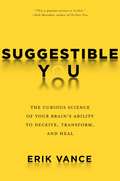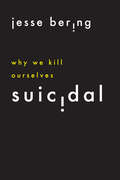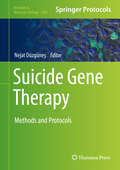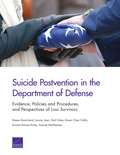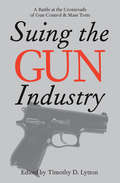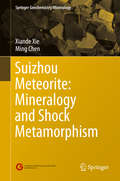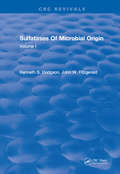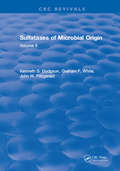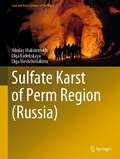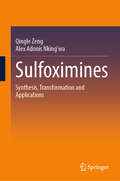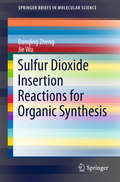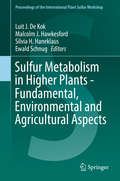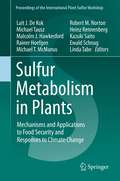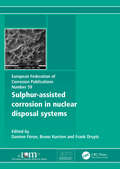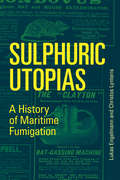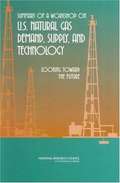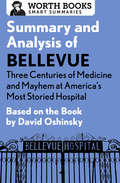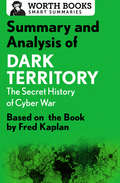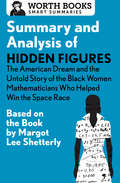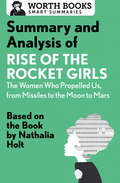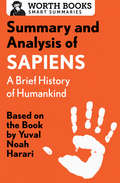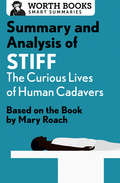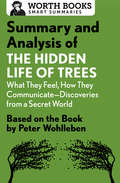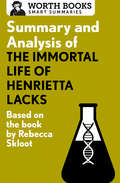- Table View
- List View
Suggestible You: The Curious Science of Your Brain's Ability to Deceive, Transform, and Heal
by Erik VanceThis riveting narrative explores the world of placebos, hypnosis, false memories, and neurology to reveal the groundbreaking science of our suggestible minds. Could the secrets to personal health lie within our own brains? Journalist Erik Vance explores the surprising ways our expectations and beliefs influence our bodily responses to pain, disease, and everyday events. Drawing on centuries of research and interviews with leading experts in the field, Vance takes us on a fascinating adventure from Harvard's research labs to a witch doctor's office in Catemaco, Mexico, to an alternative medicine school near Beijing (often called "China's Hogwarts"). Vance's firsthand dispatches will change the way you think--and feel. Expectations, beliefs, and self-deception can actively change our bodies and minds. Vance builds a case for our "internal pharmacy"--the very real chemical reactions our brains produce when we think we are experiencing pain or healing, actual or perceived. Supporting this idea is centuries of placebo research in a range of forms, from sugar pills to shock waves; studies of alternative medicine techniques heralded and condemned in different parts of the world (think crystals and chakras); and most recently, major advances in brain mapping technology. Thanks to this technology, we're learning how we might leverage our suggestibility (or lack thereof) for personalized medicine, and Vance brings us to the front lines of such study.
Suicidal: Why We Kill Ourselves
by Jesse BeringThis personal inquiry into the psychology of suicide brings “compassion, confessional honesty, and academic perception” to a woefully misunderstood subject (Kirkus Reviews).Despite his success as a psychologist and writer, Jesse Bering spent most of his thirties believing he would probably kill himself. At times, the impulse to take his own life felt all but inescapable. When his suicidal thoughts began to fade, he felt relieved—but also curious. He wondered where they came from and if they would return; whether other animals experienced the same impulse, or if it was a uniquely human evolutionary development. In Suicidal, Bering answers all these questions and more.Drawing on personal stories, scientific studies, and remarkable cross-species comparisons, Bering explores the science and psychology of suicide. Revealing its cognitive secrets and the subtle tricks our minds can play on us, Bering helps readers analyze their own doomsday thoughts while gaining broad insight into the subject. Authoritative, accessible, personal, and profound, Suicidal will change the way you think about this most vexing of human problems.
Suicide Gene Therapy: Methods and Protocols (Methods in Molecular Biology #1895)
by Nejat Düzgüneş<p>This detailed volume explores the methods used for most of the recent approaches to suicide gene therapy of cancer, which exploits promoters that are specific to cancer cells, thereby ensuring (or greatly increasing the likelihood) that the therapeutic gene is expressed only in cancer cells. The book also contains chapters describing methods to improve the safety of cell therapy and techniques utilizing bone marrow mesenchymal cells. Written for the highly successful Methods in Molecular Biology series, chapters include introductions to their respective topics, lists of the necessary materials and reagents, step-by-step, readily reproducible laboratory protocols, and tips on troubleshooting and avoiding known pitfalls. <p>Authoritative and practical, Suicide Gene Therapy: Methods and Protocols serves as an ideal guide for researchers expanding upon our knowledge and application of this vital form of cancer therapy.</p>
Suicide Postvention in the Department of Defense: Evidence, Policies and Procedures, and Perspectives of Loss Survivors
by Rajeev Ramchand Dionne Barnes-Proby Gail Fisher Lynsay Ayer Karen Chan Osilla Samuel WertheimerA review of the scientific evidence on suicide postvention (organizational responses to prevent additional suicides and help loss survivors cope), guidance for other types of organizations, and the perspectives of the family and friends of service members who have died by suicide provide insights that may help the U. S. Department of Defense formulate its own policies and programs in a practical and efficient way.
Suing the Gun Industry: A Battle at the Crossroads of Gun Control and Mass Torts
by Timothy D. Lytton"Mass tort litigation against the gun industry, with its practical weaknesses, successes, and goals, provides the framework for this collection of thoughtful essays by leading social scientists, lawyers, and academics. . . . These informed analyses reveal the complexities that make the debate so difficult to resolve. . . . Suing the Gun Industry masterfully reveals the many details contributing to the intractability of the gun debate. " -New York Law Journal "Second Amendment advocate or gun-control fanatic, all Americans who care about freedom need to readSuing the Gun Industry. " -Bob Barr, Member of Congress, 1995-2003, and Twenty-First Century Liberties Chair for Freedom and Privacy, American Conservative Union "Thesource for anyone interested in a balanced analysis of the lawsuits against the gun industry. " -David Hemenway, Professor of Health Policy & Director, Harvard Injury Control Research Center Harvard School of Public Health Health Policy and Management Department, author ofPrivate Guns, Public Health "Highly readable, comprehensive, well-balanced. It contains everything you need to know, and on all sides, about the wave of lawsuits against U. S. gun manufacturers. " -James B. Jacobs, Warren E. Burger Professor of Law and author ofCan Gun Control Work? "InSuing the Gun Industry, Timothy Lytton has assembled some of the leading scholars and advocates, both pro and con, to analyze this fascinating effort to circumvent the well-known political obstacles to more effective gun control. This fine book offers a briefing on both the substance and the legal process of this wave of lawsuits, together with a better understanding of the future prospects for this type of litigation vis-à-vis other industries. " -Philip J. Cook, Duke University "An interesting collection, generally representing the center of the gun-control debate, with considerable variation in focus, objectivity, and political realism. " -Paul Blackman, retired pro-gun criminologist and advocate Gun litigation deserves a closer look amid the lessons learned from decades of legal action against the makers of asbestos, Agent Orange, silicone breast implants, and tobacco products, among others. Suing the Gun Industrycollects the diverse and often conflicting opinions of an outstanding cast of specialists in law, public health, public policy, and criminology and distills them into a complete picture of the intricacies of gun litigation and its repercussions for gun control. Using multiple perspectives,Suing the Gun Industryscrutinizes legal action against the gun industry. Such a broad approach highlights the role of this litigation within two larger controversies: one over government efforts to reduce gun violence, and the other over the use of mass torts to regulate unpopular industries. Readers will findSuing the Gun Industrya timely and accessible picture of these complex and controversial issues. Contributors: Tom Baker Donald Braman Brannon P. Denning Tom Diaz Howard M. Erichson Thomas O. Farrish Shannon Frattaroli John Gastil Dan M. Kahan Don B. Kates Timothy D. Lytton Julie Samia Mair Richard A. Nagareda Peter H. Schuck Stephen D. Sugarman Stephen Teret Wendy Wagner
Suizhou Meteorite: Mineralogy and Shock Metamorphism
by Ming Chen Xiande XieThis book introduces the unusual shock-related mineralogical features of the shocked Suizhou L6 (S5) meteorite. The olivine and pyroxene in Suizhou display a mosaic shock feature, while most of plagioclase grains have transformed to glassy maskelynite. A few of the shock-induced melt veins in the meteorite are the simplest, straightest and thinnest ones among all shock-vein-bearing meteorites, and contain the most abundant high-pressure mineral species. Among the 11 identified species, tuite, xieite, and the post-spinel CF-phase of chromite are new minerals. The meteorite experienced a peak shock pressure up to 24 GPa and temperatures of up to 1000° C. Locally developed shock veins were formed at the same pressure, but at an elevated temperature of about 2000° C that was produced by localized shear-friction stress. The rapid cooling of the extremely thin shock veins is the main reason why 11 shock-induced high-pressure mineral phases could be preserved in them so well. This book offers a helpful guide for meteoritics researchers and mineralogists and invaluable resource for specialists working in high-pressure and high-temperature mineralophysics.
Sulfatases Of Microbial Origin: Volume 1
by Kenneth S. DodgsonIn the succeeding pages the authors have collated scattered information about individual sulfatases and have endeavoured to indicate their physiological roles within the microorganism, the ways in which their synthesis is subject to genetic and physiological control, and their participation in natural processes such as the recycling sulfur. The authors have also attempted, for the first time, to discuss at length the mechanisms of action of some of the enzymes in relation to current knowledge about the nonenzymic hydrolysis of various types of sulfate ester. Although primarily directed towards those people interested in biochemistry and enzymology of microorganisms, it is the authors belief that there will be much in the book that will be of interest to worker in the mammalian field.
Sulfatases Of Microbial Origin: Volume 2
by Kenneth S. DodgsonIn the succeeding pages the authors have collated scattered information about individual sulfatases and have endeavoured to indicate their physiological roles within the microorganism, the ways in which their synthesis is subject to genetic and physiological control, and their participation in natural processes such as the recycling sulfur. The authors have also attempted, for the first time, to discuss at length the mechanisms of action of some of the enzymes in relation to current knowledge about the nonenzymic hydrolysis of various types of sulfate ester. Although primarily directed towards those people interested in biochemistry and enzymology of microorganisms, it is the authors belief that there will be much in the book that will be of interest to worker in the mammalian field.
Sulfate Karst of Perm Region (Cave and Karst Systems of the World)
by Nikolay Maksimovich Olga Meshcheriakova Olga KadebskayaThe book provides a characteristic of sulfate karst, the features of its distribution and development in the Perm region, based on their own research and generalization of data accumulated in recent years. An updated zoning of the territory is given, partly based on the use of GIS technologies. This book also offers a detailed description of areas with characteristics of geological and hydrogeological conditions for the development of karst and karst phenomena. Besides, it also provides a detailed description of a number of caves, information about specially protected natural areas associated with sulfate karst and new unique objects that need protection. The book describes the influence of karst on economic activity and the ecological situation.The publication is intended for geologists, geographers, ecologists, karst scientists, speleologists, local historians, teachers and students of specialties related to earth sciences, as well as a wide range of karst and cave enthusiasts.
Sulfate-Reducing Bacteria and Archaea
by Larry L. Barton Guy D. FauqueThe abundance of sulfate-reducing bacteria and archaea (SRBA) is impressive and new isolates are being reported continuously. A few decades ago, only two genera of sulfate-reducing bacteria (SRB) had been identified. As of 2018, 92 genera containing more than 420 species of SRB have been isolated and characterized and there are several species of archaea. This book addresses the development of the research with SRBA and includes historical background of this field. Biochemical characterization of the enzymes, cytochromes and electron carriers involved with dissimilatory sulfate reduction are reviewed and the presence of relevant genes in cultured and uncultured SRBA are assessed using genome analysis. The contributions of transmembrane electron transport complexes as related to cell energetics are discussed. This book highlights the unique cellular and molecular features of the SRBA and discusses the biochemical interactions behind their metabolic capabilities which enable SRBA to grow in extreme environments. Examples are provided to detoxify and alleviate pollution situations, to evaluate mechanisms proposed for corrosion of ferrous metals and to examine the effects of SRB on human and animal hosts.
Sulfoximines: Synthesis, Transformation and Applications
by Qingle Zeng Alex Adonis Nking’waThis book provides an easy to understand explanation of sulfoximines, explaining how they are made, structural complexities, and how they are used, especially in medicinal chemistry. You will learn new ways to synthesize these compounds and discover how they can help in drugs discovery and development. Key topics include how to synthesize sulfoximines, cyclic sulfoximines, their special properties, and their applications. These compounds are important because they can lead to new and more effective drugs. Understanding sulfoximines can help researchers develop better treatments for various diseases. This work addresses the challenge of finding better methods for drug discovery. By offering clear explanations and practical examples, it helps bridge the gap between theory and practice. The focus on sulfoximines’ unique qualities and their potential in medicine makes this book a valuable resource for anyone in the pharmaceutical field. Special features include clear visuals, detailed schemes, and an easy-to-follow approach that makes complex ideas simple. This book is suitable for researchers, chemists, and students. It guides readers through the world of sulfoximines, helping them understand their importance in modern drugs. Whether you are an experienced researcher or a student, this guide will help you explore the latest advancements in sulfoximine chemistry.
Sulfur Dioxide Insertion Reactions for Organic Synthesis
by Jie Wu Danqing ZhengThis brief summarizes the most commonly used sulfur dioxide surrogates and also shows the diverse reactivities to highlight the advances made in the development of synthetic methods through the insertion of sulfur dioxide. Depending on the nature of the transformation, these reactions are classified into four types: (i) pericyclic reactions; (ii) nucleophilic addition with organometallic reagents; (iii) transition metal catalysis; and (iv) free radical reactions. Highlighting recent advances in the insertion of sulfur dioxide, providing detailed descriptions of the experimental procedures for these valuable reactions, and discussing the remaining challenges in this field, the brief offers an appealing and highly useful guide for a wide readership in organic chemistry and medicinal chemistry from both academia and industry.
Sulfur Metabolism in Higher Plants - Fundamental, Environmental and Agricultural Aspects
by Malcolm J. Hawkesford Ewald Schnug Luit J. De Kok Silvia H. HaneklausThis proceedings volume contains a selection of invited and contributed papers of the 10th International Workshop on Sulfur Metabolism in Plants, which was held in Goslar, Germany September 1-4, 2015. The focus of this workshop was on the fundamental, environmental and agricultural aspects of sulfur in plants, and presents an overview of the progress in the research developments in this field in the 28 years since the first of these workshops. The volume covers various aspects of the regulation of the uptake and assimilation of sulfate in plants from a molecular to a whole plant level with an emphasis on the significance of sulfur metabolism in plant responses to stress and in food security.
Sulfur Metabolism in Plants
by Malcolm J. Hawkesford Michael T. Mcmanus Ewald Schnug Luit J. De Kok Michael Tausz Linda Tabe Kazuki Saito Heinz Rennenberg Robert Norton Rainer HoefgenThis proceedings volume contains the invited and a selection of the contributed papers of the 8th International Workshop on Sulfur Metabolism in Higher Plants, which was held at Department of Forest and Ecosystem Science, University of Melbourne, Water Street, Creswick, Victoria 3363, Australia from November 22-27, 2010. Content of the volume shows that the understanding of sulfur metabolism in plants and the interaction of the environment are rapidly progressing. This volume covers various aspects of the regulation of sulfate uptake and assimilation in plants, from a cellular to a whole plant level, and additionally emphasizes interactions with other minerals. Moreover the significance of sulfur metabolism in biotic and abiotic stress responses, in food security and quality, and in relation to interactions with global change factors is discussed in detail.
Sulphur-Assisted Corrosion in Nuclear Disposal Systems
by Damien FéronIn the different disposal concepts for high-level nuclear waste, corrosion of the metallic barriers and in particular the overpack/container is a major issue. It is imperative for performance assessment to predict the lifetime of these containers. In the lifetime prediction of metallic barriers for the disposal of high level nuclear waste (HLW) or of spent fuel, the presence of (reduced) sulphur species is an issue of growing importance, as the sulphur species are involved in localised corrosion phenomena. The international workshop on Sulphur-Assisted Corrosion in Nuclear Waste Disposal Systems (SACNUC2008) aimed to provide an exchange of information on the influence of sulphur species on the corrosion of metallic barriers. This workshop was a co-organisation of the Belgian Nuclear Research Centre, SCK*CEN, and the Belgian Agency for the Management of Radioactive Waste and Enriched Fissile Materials, ONDRAF/NIRAS, under the auspices of the European Federation of Corrosion (EFC event N 311). The proceedings are divided into five chapters: Chapter 1 provides a general overview of the disposal concepts of nuclear waste and the role of corrosion. Chapter 2 explains the mechanism of sulphur-induced corrosion processes. This chapter also contains information from outside the nuclear disposal field in which sulphur is known to act as a detrimental factor (e.g. oil and gas industry). Chapter 3 addresses the role of microbial processes in sulphur-assisted corrosion. Chapter 4 covers the modelling of sulphide-assisted corrosion. Chapter 5 is devoted to a panel discussion aiming to identify open issues in the investigation of sulphur-assisted corrosion phenomena and how to incorporate these in robust lifetime prediction of metallic barriers.
Sulphuric Utopias: A History of Maritime Fumigation (Inside Technology)
by Christos Lynteris Lukas EngelmannHow early twentieth century fumigation technologies transformed maritime quarantine practices and inspired utopian visions of disease-free global trade.In the late nineteenth and early twentieth centuries, fumigation technologies transformed global practices of maritime quarantine through chemical and engineering innovation. One of these technologies, the widely used Clayton machine, blasted sulphuric acid gas through a docked ship in an effort to eliminate pathogens, insects, and rats while leaving the cargo and the structure of the vessel unharmed, shortening its time in quarantine and minimizing the risk of importing infectious diseases. In Sulphuric Utopias, Lukas Engelmann and Christos Lynteris examine this overlooked but historically crucial practice at the intersection of epidemiology, hygiene, applied chemistry, and engineering. They show how maritime fumigation inspired utopian visions of disease-free trade to improve global shipping and to encourage universally applicable standards of sanitation and hygiene.Engelmann and Lynteris chart the history of ideas about fumigation, disinfection, and quarantine, and chronicle the development of the Clayton machine in 1880s New Orleans. Built by the Louisiana Board of Health and adapted and patented by Thomas Clayton, the machine offered a barrier against bacteria and pests and enabled a highway to global trade. Engelmann and Lynteris chronicle the Clayton machine's success and examine its competitors, including carbon-based fumigation methods in Germany and the Ottoman Empire as well as the “Sulfurozador” in Argentina. They follow the international standardization of maritime fumigation and explore the Clayton machine's decline after World War I, when visions of “sulphuric utopia” were replaced by a pragmatic acknowledgment of epidemiological complexity.
Summary Of A Workshop On U.s. Natural Gas Demand, Supply, And Technology: Looking Toward The Future
by Committee on U.S. Natural Gas Demand Supply Projections: A WorkshopThe workshop examined the following three questions: (1) What projections have been made by government agencies for the U. S. supply of and demand for natural gas over the next 10 to 20 years? (2) Where are the current natural gas reserves and resources? (3) By what means and by how much can future reserves, resources, and production be increased?
Summary and Analysis of Bellevue: Based on the Book by David Oshinsky (Smart Summaries)
by Worth BooksSo much to read, so little time? This brief overview of Bellevue tells you what you need to know—before or after you read David Oshinsky&’s book. Crafted and edited with care, Worth Books set the standard for quality and give you the tools you need to be a well-informed reader. This short summary and analysis of Bellevue includes: Historical contextChapter-by-chapter overviewsCharacter profilesDetailed timeline of key eventsImportant quotes and analysisFascinating triviaGlossary of termsSupporting material to enhance your understanding of the original workAbout Bellevue: Three Centuries of Medicine and Mayhem at America&’s Most Storied Hospital by David Oshinsky: Pulitzer Prize–winning historian David Oshinsky provides a comprehensive account of New York City&’s famous Bellevue Hospital, from its early inception as a poorhouse infirmary to its most recent struggles and triumphs, including a dramatic evacuation during Hurricane Sandy and the successful treatment of an Ebola patient. In the centuries between, the hospital contends with epidemics ranging from yellow fever to AIDS, a meddling journalist named Nellie Bly, and the tragic murder of a doctor on hospital grounds by a mental patient. Some of Bellevue&’s finest staff are highlighted, including two doctors who operated on American presidents and two others who virtually invented forensic science. The history of Bellevue is the history of New York City, in all of its complicated and controversial glory, and its mission to serve the underprivileged is a fulfillment of the duty inscribed on the Statue of Liberty: &“Give me your tired, your poor, your huddled masses.&” The summary and analysis in this ebook are intended to complement your reading experience and bring you closer to a great work of nonfiction.
Summary and Analysis of Dark Territory: Based on the Book by Fred Kaplan
by Worth BooksSo much to read, so little time? This brief overview of Dark Territory: The Secret History of Cyber War tells you what you need to know—before or after you read Fred Kaplan’s book. Crafted and edited with care, Worth Books set the standard for quality and give you the tools you need to be a well-informed reader. This short summary and analysis of Dark Territory includes: Historical contextChapter-by-chapter overviewsProfiles of the main charactersDetailed timeline of key eventsImportant quotesFascinating triviaGlossary of termsSupporting material to enhance your understanding of the original workAbout Dark Territory by Fred Kaplan: Dark Territory traces the secret history of US intelligence in the Internet age and describes how cyberwarfare has evolved since the 1980s. Pulitzer Prize–winning journalist and Slate columnist Fred Kaplan reveals the major players, events, and technologies that have transformed the nature of war from being about bombs and bullets to bits and bytes. Although Edward Snowden brought it into the public spotlight, the National Security Agency’s operations have been involved in US and international policy for years through secret operations, espionage, and counterintelligence. Dark Territory is the covert and dangerous history of a war very few knew was being waged that continues to shape our future. The summary and analysis in this ebook are intended to complement your reading experience and bring you closer to a great work of nonfiction.
Summary and Analysis of Hidden Figures: Based on the Book by Margot Lee Shetterly (Smart Summaries)
by Worth BooksSo much to read, so little time? Get an overview of Hidden Figures, the true story about the African American female mathematicians who helped NASA win the space race. Margot Lee Shetterly&’s Hidden Figures tells the incredible real-life account of Dorothy Vaughan, Mary Jackson, Katherine Johnson, and Christine Darden—who, in a time when black women faced seemingly insurmountable obstacles, went to work as &“calculators&” at NASA. With pencils, paper, and slide rules, they transformed airplane, rocket, and satellite designs—and ensured a World War II victory. Despite the social and political climate at the height of Jim Crow, these women rose up and became integral to the project that put the first man on the moon. From World War II to the Cold War to the civil rights movement to the space race, Hidden Figures tells the story of four remarkable women whose contributions to science led to some of NASA&’s greatest successes. The book has become a New York Times bestseller as well as a Screen Actors Guild Award–winning and Academy Award–nominated picture starring Taraji P. Henson, Octavia Spencer, Kirsten Dunst, and Kevin Costner. With historical context, important quotes, fascinating trivia, a glossary of terms, and other features, this summary and analysis of Hidden Figures: The American Dream and the Untold Story of the Black Women Mathematicians Who Helped Win the Space Race is intended to complement your reading experience and bring you closer to a great work of nonfiction.
Summary and Analysis of Rise of the Rocket Girls: Based on the Book by Nathalia Holt
by Worth BooksSo much to read, so little time? This brief overview of Rise of the Rocket Girls tells you what you need to know—before or after you read Nathalia Holt’s book. Crafted and edited with care, Worth Books set the standard for quality and give you the tools you need to be a well-informed reader. This short summary and analysis of Rise of the Rocket Girls includes: Historical contextChapter-by-chapter overviewsProfiles of the main charactersDetailed timeline of key eventsImportant quotesFascinating triviaGlossary of termsSupporting material to enhance your understanding of the original work About Rise of the Rocket Girls: The Women Who Propelled Us, from Missiles to the Moon to Mars by Nathalia Holt: When the Jet Propulsion Laboratory first began researching rocket science and the possibilities within space exploration in the middle of the twentieth century, they hired a hyper intelligent group of female mathematicians to work with their staff of engineers. In Rise of the Rocket Girls: The Women Who Propelled Us, from Missiles to the Moon to Mars, Nathalia Holt examines four decades of the JPL’s major accomplishments from interviews and research of these groundbreaking women who were recruited to be “human computers,” Including, from this team of unsung heroes, Barbara Paulson, Helen Ling, Sue Finley, and Sylvia Lundy. As the JPL’s projects evolved from developing missiles and satellites to executing moon landings and planetary exploration projects, the women’s roles grew too, becoming the team responsible for launching America into Space—and they did it all while balancing marriage and children, too. The summary and analysis in this ebook are intended to complement your reading experience and bring you closer to a great work of nonfiction.
Summary and Analysis of Sapiens: Based on the Book by Yuval Noah Harari
by Worth BooksSo much to read, so little time? This brief overview of Sapiens: A Brief History of Humankind tells you what you need to know—before or after you read Yuval Noah Harari’s book. Crafted and edited with care, Worth Books set the standard for quality and give you the tools you need to be a well-informed reader. This short summary and analysis of Sapiens includes: Historical contextChapter-by-chapter overviewsCharacter profilesDetailed timeline of key eventsImportant quotesFascinating triviaGlossary of termsSupporting material to enhance your understanding of the original workAbout Sapiens: A Brief History of Humankind by Yuval Noah Harari: Sapiens is a wide-ranging account of human history that upends the conventional wisdom about our species with novel, even startling, theories about how we developed and where we’re headed. The bestselling book Sapiens takes the reader from humanity’s remote origins in East Africa; through its spread to societies and empires around the world; and finally to the present, when Sapiens as we know them may be about to disappear. Throughout this journey, Homo Deus author Yuval Noah Harari offers new insights into the importance of language, imagination, and even ignorance in the development of human history. The summary and analysis in this ebook are intended to complement your reading experience and bring you closer to a great work of nonfiction.
Summary and Analysis of Stiff: Based on the Book by Mary Roach
by Worth BooksSo much to read, so little time? This brief overview of Stiff tells you what you need to know—before or after you read Mary Roach’s book. Crafted and edited with care, Worth Books set the standard for quality and give you the tools you need to be a well-informed reader. This short summary and analysis of Stiff: The Curious Lives of Human Cadavers by Mary Roach includes: Historical contextChapter-by-chapter summariesProfiles of the characters and placesImportant quotesFascinating triviaGlossary of termsSupporting material to enhance your understanding of the original work About Stiff: The Curious Lives of Human Cadavers by Mary Roach: Acclaimed journalist Mary Roach’s bestselling book Stiff offers an inside look through the through the weird world of human cadavers. This globe-spanning story is deeply informative, surprisingly funny, and occasionally disgusting. These “superheroes,” as Roach refers to them, brave high-speed car crashes, gunshots, decomposition in the sun, and other indignities all in the name of advancing science and making life better for the living. The summary and analysis in this ebook are intended to complement your reading experience and bring you closer to a great work of nonfiction.
Summary and Analysis of The Hidden Life of Trees: Based on the Book by Peter Wohlleben (Smart Summaries)
by Worth BooksSo much to read, so little time? This brief overview of The Hidden Life of Trees tells you what you need to know—before or after you read Peter Wohlleben&’s book. Crafted and edited with care, Worth Books set the standard for quality and give you the tools you need to be a well-informed reader. This short summary and analysis of The Hidden Life of Trees includes: Historical contextChapter-by-chapter overviewsProfiles of the main charactersImportant quotesFascinating triviaGlossary of termsSupporting material to enhance your understanding of the original work About The Hidden Life of Trees by Peter Wohlleben: The Hidden Life of Trees explains the astonishing ways trees interact with each other and respond to their environment. It details how they communicate via underground fungal networks, provide sugar to help trees that are stressed, warn each other of insect or fungal attacks, and coordinate their growth and reproduction. The author also describes how forestry methods can be improved to work with this complex inter-tree network to allow for healthier trees. Naturalist Peter Wohlleben puts into context the invaluable role forests play in sequestering carbon, talks about the contribution that large, old trees can play in battling climate change, and how caring for woodlands is vital to all life on earth. The summary and analysis in this ebook are intended to complement your reading experience and bring you closer to a great work of nonfiction.
Summary and Analysis of The Immortal Life of Henrietta Lacks: Based on the Book by Rebecca Skloot
by Worth BooksSo much to read, so little time? This brief overview of The Immortal Life of Henrietta Lacks tells you what you need to know—before or after you read the original book. Crafted and edited with care, Worth Books set the standard for quality and gives you the tools you need to be a well-informed reader. This short summary and analysis of The Immortal Life of Henrietta Lacks by Rebecca Skloot includes: Historical contextPart-by-part summaryContext and analysisDetailed timeline of key eventsCast of charactersImportant quotesFascinating triviaSupporting material to enhance your understanding of the original work About The Immortal Life of Henrietta Lacks by Rebecca Skloot: For decades, scientists have been using “HeLa” cells in biological research, from the polio vaccine and the nature of cancer to studying how human cells behave in outer space. This famous cell line began as a sample of cells taken from a poor African American mother of five named Henrietta Lacks. Henrietta died of cervical cancer in 1951 without before ever knowing that medical professionals from Johns Hopkins had taken these cells without her consent. When her family finds out that Henrietta’s cells are being bought and sold in labs around the world, they unwittingly find themselves at the intersection of a debate on science, race, and medical ethics. In her New York Times #1 bestseller, science journalist Rebecca Skloot tells the story of the woman behind the cells and her family’s struggle with the medical institutions that failed to acknowledge the human cost of scientific advancement. The summary and analysis in this ebook are intended to complement your reading experience and bring you closer to a great work of nonfiction.
